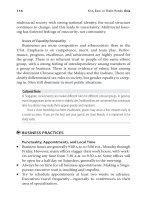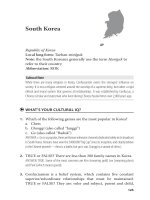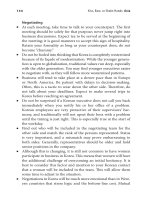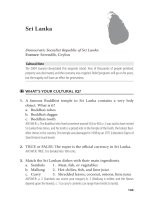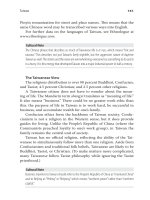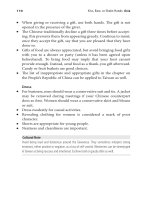Tài liệu How to Do Business in 12 Asian Countries 6 ppt
Bạn đang xem bản rút gọn của tài liệu. Xem và tải ngay bản đầy đủ của tài liệu tại đây (108.13 KB, 9 trang )
26 Kiss, Bow, or Shake Hands: Asia
About 2 percent of Indians are Sikhs. Sikhism combines tenets of
both Hinduism and Islam. Sikhs believe in reincarnation but do not
recognize caste distinctions. Unlike Hindus, Sikhs reject noninter-
vention with the world as cowardly.
India also has Christians, Buddhists, Jains, and Zoroastrians. e
Republic of India has no ocial religion.
e origins of the caste system are unclear, but it has existed in
India for thousands of years. Even though the government has out-
lawed discrimination on the basis of caste, castes still play a signi-
cant role in the politics and business of the country. Although there
are only four traditional castes, these are broken down into thousands
of subcastes.
■
*
Know Before You Go
India has suffered everything from cyclones (in 1999 at least 10,000 died in the eastern
state of Orissa) to massive earthquakes (approximately 30,000 dead in Gujarat during
2001) to the devastation of the tsunami in southern India in 2004. Additional hazards
include droughts, flash floods from monsoons, and extreme weather changes in the
Himalayas.
Stay healthy on your trip. Listen to your doctor’s advice prior to your visit (and take
your vaccinations against hepatitis A, cholera, etc.). Many travelers fall ill because of over-
indulging in spicy foods or eating raw fruits or vegetables that have been contaminated.
Drink bottled water, wear sunscreen, and be certain to bring any required medications
with you.
●
3
CULTURAL ORIENTATION
Cognitive Styles: How Indians Organize
and Process Information
In India information is accepted openly as long as it does not
challenge religious and social structures. Because of rote learning
and tradition, most thinking is associative. However, highly educated
Indians are more abstractive and analytical. Although universal rules
of behavior exist within the social structure, immediate situations
and people are of major concern, but always within the constructs of
the caste system.
Negotiation Strategies: What Indians Accept as Evidence
Personal feelings form the basis for the truth, but a strong faith in
religious ideologies is always present. e use of objective facts is less
persuasive than a combination of feelings and faith.
Value Systems: The Basis for Behavior
Although it is constantly being challenged by younger citizens,
India still has an attachment to the caste system, with all of its social
structure and liabilities. e following three sections identify the
Value Systems in the predominant culture—their mode of dividing
right from wrong, good from evil, and so forth.
Locus of Decision-Making
India is a moderately collectivistic culture in which an individual’s
decisions must be in harmony with the family, group, and social
structure. Success and failure are oen attributed to environmental
factors. Friendships and kinships are more important than expertise,
although diplomas and certicates are coveted. One must build a rela-
tionship with other participants in the negotiation process by discuss-
ing friends and family. Indians may oen be too polite to say “no.”
Sources of Anxiety Reduction
With such a strong social structure, there is little anxiety about
life because individuals know and accept their place in the society or
organization. Behaviors contrary to religious traditions are not easily
tolerated. ere is a strong sense of what Westerners call “fatalism,”
so time is not a major source of anxiety, and passivity is a virtue.
Emotions can be shown, and assertiveness is expected.
Issues of Equality/Inequality
ere is a very rigid structure of inequality, even though there is
equality under the law (seldom enforced). e belief that there are
qualitative dierences between the castes is ingrained. Traditional
male chauvinism is strong, and women do not have equal privileges.
e abundant sexual symbols in society do not translate into an
acceptance of public intimacy.
India 27
28 Kiss, Bow, or Shake Hands: Asia
Cultural Note
Tipping in India is more than just a reward for good service; it is often the way to ensure
that things get done. The term baksheesh encompasses both these meanings. Judicious (and
discreet) use of baksheesh will often open closed doors, such as getting a seat on a “sold-out”
train.
●
3
BUSINESS PRACTICES
Punctuality, Appointments, and Local Time
●
Business hours vary all over India, but generally they are from
9:30 .. to 5:00 .., Monday through Friday (lunch is usually
from 1:00 to 2:00 ..). Government oce hours may be shorter,
but they are open on some Saturdays.
●
Indians appreciate punctuality but do not always practice it them-
selves. Keep your schedule loose enough for last-minute resched-
uling of meetings.
●
Request appointments as far ahead as possible. Advances in com-
munication systems have made it far easier to schedule meetings,
but it is still appropriate to get on the schedule of executives as
early as possible.
●
Be aware that your Indian contacts may request impromptu meet-
ings at late hours.
●
Make sure that you are fully equipped with the latest wireless and
telecom devices before you arrive in India—your prospects will
want multiple ways to contact you and will expect you to invest in
technology.
●
Although they usually do not make nal decisions, middle man-
agers do have input. A middle manager on your side can forward
your proposal. Oen they are more accessible, and they are will-
ing to meet at any time of the day.
●
Go to the top of the company for major decisions.
●
Indian executives generally prefer late morning or early aernoon
appointments, between 11:00 .. and 4:00 ..
●
e best time of year to visit India is between October and March,
bypassing the seasons of extreme heat and monsoons.
●
Business is not conducted during religious holidays, which are
numerous. Dates for these holidays change from year to year, so
conrm your schedule with local contacts, and check for current
holidays at www.kissboworshakehands.com.
●
India is ve and a half hours ahead of Greenwich Mean Time
(G.M.T. + 5½), or ten and a half hours ahead of Eastern Standard
Time (E.S.T. + 10½ hours).
●
India operates in one time zone, and although it does not observe
daylight-saving time, many visitors have mentioned their use of
IST (Indian Stretchable Time).
Negotiating
●
Indians have a less hurried attitude toward time than North Ameri-
cans. e concept “time is money” is alien to many Indians.
●
While you should get sound legal and tax advice before negotiat-
ing any agreement, it is important to be exible and not appear
too legalistic during negotiations.
●
Be prepared to oer competitive technology packages with close
technical follow-up. e technical assistance you can provide and
how eective your training support is will be critical factors in the
decision.
●
Expect delays; they are inevitable. e Indian government moves
at its own pace, and communication within India may still be
somewhat dicult. Be patient, and make a realistic assessment of
the steps and time involved in nalizing any agreements.
●
Always present your business card. It is not necessary to have it
translated into an Indian language.
●
Business in India is highly personal. A great amount of hospitality
is associated with doing business. Tea and small talk are preludes
to most discussions.
●
When refreshments are oered, it is customary to refuse the rst
oer, but to accept the second or third. To completely refuse any
refreshment is an insult. Drink slowly if you wish to limit your
intake of the sugary, milky Indian tea.
●
e word “no” has harsh implications in India. Evasive refusals
are more common, and are considered more polite. Never directly
India 29
30 Kiss, Bow, or Shake Hands: Asia
refuse an invitation—just be vague and avoid a time commitment.
“I’ll try” is an acceptable refusal.
Cultural Note
In a monetary transaction, your change is simply placed in your hand, without explanation of the
amount. If you remain standing with your hand outstretched, you may receive more change.
Be sure to keep lots of small change on hand, because street merchants and taxi drivers
often claim they do not have change.
●
3
BUSINESS ENTERTAINING
●
Business lunches are preferred to dinners.
●
Remember that Hindus do not eat beef and Muslims do not eat
pork.
●
Businesswomen may host Indian businessmen at a meal without
embarrassing the men, although the men may try to pay at the
end of the meal. Female executives should arrange with the waiter
to pay the bill before the meal.
●
If you are invited to dinner, be a few minutes late unless it is an
ocial function. If the dinner is in a home, you may arrive een
to thirty minutes late.
●
Eat only with the right hand, because the le hand was tradition-
ally used for hygienic purposes and is considered unclean.
●
Touching a communal dish with your hands may cause fellow
diners to avoid it.
●
Never oer another person (even a spouse) food from your plate,
as it is considered “polluted” as soon as it is placed on your plate.
●
Washing your hands both before and aer a meal is important. In
Hindu homes, you are expected to rinse your mouth out as well.
●
Do not thank your hosts at the end of a meal. Saying “thank you”
for a meal is insulting because the thanks are considered a form
of payment. Returning the meal by inviting your hosts to dinner
shows that you value the relationship.
●
India’s two major religions abjure beef and pork, so it is not surpris-
ing that Indian cuisine uses mostly chicken, lamb, or vegetables.
Cultural Note
Here’s one rude move you should be especially aware of in India. If you must share a bottle of
water, tilt your head back and pour it into your mouth from above . . . without touching your
lips. Don’t put your mouth on the bottle and then try to pass it to the next parched soul. That
would be jootha. The term “jootha” refers to a breach of conduct where your germs are being
spread around, rather than your goodwill. Sharing is not always a virtue!
●
3
PROTOCOL
Greetings
●
In large cities, men and very westernized Indian women will oer
to shake hands with foreign men and sometimes with foreign
women. Western women should not initiate handshaking with
Indian men.
●
ere are numerous ethnic, linguistic, and religious groups in
India, each with its own traditions.
●
e majority of Indians are Hindu. Most Hindus avoid public
contact between men and women. Men may shake hands with
men, and women with women, but only westernized Hindus will
shake hands with the opposite sex.
●
A minority of Indians are Muslim. Traditionally, there is no
physical contact between Muslim men and women. Indeed, if an
orthodox Muslim male is touched by a woman, he must ritually
cleanse himself before he prays again. Because of this, women
should not oer to shake hands with Muslim men (nor should
men oer to shake hands with Muslim women). Of course, if a
westernized Indian oers to shake hands, do so. Other Indian
religious groups, such as Sikhs, also avoid public contact between
the sexes.
●
e traditional Indian greeting is the namaste. To perform the
namaste, press the palms of your hands together (as if praying)
below the chin, near the heart, and gently nod or bow slightly.
ere are many Web sites that describe the meaning of the
namaste, and how this peaceful greeting can be appropriate for
individuals or for large meetings.
India 31
32 Kiss, Bow, or Shake Hands: Asia
●
A namaste is useful for foreigners in any situation where a hand-
shake might not be acceptable. It is also a good alternative to a
handshake when a Western businesswoman greets an Indian
man.
●
Indians of all ethnic groups disapprove of public displays of aec-
tion between people of the opposite sex. Do not touch (except in
handshaking), hug, or kiss in greeting.
Cultural Note
Giving money to a beggar will result in your being besieged by dozens of them. Unless you
wish to distribute alms to many of India’s poor, avoid even making eye contact.
When walking past an Indian temple, keep your hands in your pockets. If your hand is
free, a stranger may offer to shake your hand. They are often street merchants who quickly
slap a temple bracelet on your outstretched arm. Then you are expected to pay for the
bracelet.
Titles/Forms of Address
●
It is important to note that India’s naming conventions are
changing. For example, the Southern region of India seems to be
gradually moving toward the naming customs of the North, and
professional females are starting to keep their maiden names.
●
Titles are highly valued by Indians. Always use professional titles,
such as “Professor” and “Doctor.” Don’t address someone by his
or her rst name unless you are asked to or you are close friends;
use “Mr.,” “Mrs.,” or “Miss.”
●
For a full discussion of titles and forms of address in India, see
Appendix A.
Cultural Note
Among Indians, a side-to-side toss of the head indicates agreement, although Westerners
may interpret it as meaning “no.” Watch carefully; the Indian head toss is not quite the same as
the Western negative nod (which leads with the jaw).
On the other hand, the North American up-and-down head nod (used to signify “yes”)
can be confusing to Indians, because a form of that gesture can imply “no” in India.
Gestures
●
Many Indians consider the head to be the seat of the soul. Never
touch someone else’s head, not even to pat the hair of a child.
●
As in much of the world, to beckon someone, you hold your
hand out, palm downward, and make a scooping motion with the
ngers. Beckoning someone with the palm up and wagging one
nger can be construed as an insult.
●
Standing tall with your hands on your hips—the “arms akimbo”
position (also the gesture for “Osides!” in soccer)—will be inter-
preted as an angry, aggressive posture.
●
e comfortable standing distance between two people in India
varies with the culture. In general, Hindu Indians tend to stand
about three or three and a half feet apart.
●
Pointing with a nger is rude; Indians point with the chin.
●
Whistling under any circumstances is considered impolite.
●
Winking may be misinterpreted as either an insult or a sexual
proposition.
●
Grasping your ears designates sincerity or repentance. Ears are
considered sacred appendages; to pull or box someone’s ears is a
great insult.
●
Never point your feet at a person. Feet are considered unclean. If
your shoes or feet touch another person, apologize.
Gifts
●
Gis are not opened in the presence of the giver. If you receive a
wrapped gi, set it aside until the giver leaves.
●
If you are invited to an Indian’s home for dinner, bring a small
gi of chocolates or owers. Don’t give frangipani blossoms, how-
ever—they are associated with funerals.
●
Don’t wrap gis in black or white, which are considered unlucky
colors; green, red, and yellow are lucky colors.
●
If you know that your Indian counterpart drinks alcohol, bring
imported whiskey. High taxes can be avoided by purchasing the
liquor on the airline or at the duty-free shop before arriving.
●
Muslims consider dogs unclean. Do not give toy dogs or gis with
pictures of dogs to Indian Muslims.
India 33
34 Kiss, Bow, or Shake Hands: Asia
●
Should you give money to an Indian, make sure it is an odd num-
ber. Usually this is done by adding a single dollar; for example,
give $11 instead of $10.
●
For more guidelines on culturally correct gis in India, visit www
.kissboworshakehands.com.
Dress
●
For business dress, men should wear a suit and tie, although the
jacket may be removed in the summer. Businesswomen should
wear conservative dresses or pantsuits.
●
For casual wear, short-sleeved shirts and long trousers are pre-
ferred for men; shorts are acceptable only while jogging. Women
must keep their upper arms, chest, back, and legs covered at all
times. Women who jog should wear long pants.
●
Note that wearing leather (including belts, handbags, or purses)
may be considered oensive, especially in temples. Hindus revere
cows, and do not use leather products.



